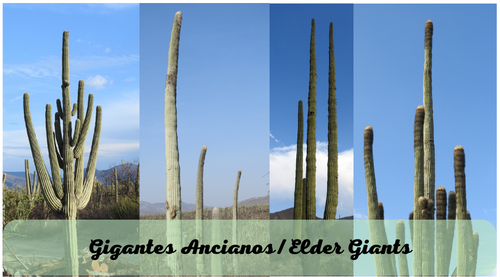
Hi, #Hivers!
I recently returned from a several-day stay in the desert, which I did as part of a data collection for my PhD thesis. It was a very interesting and intense experience, so I'd like to share with the members of this community and the @amazingnature community a bit of what I learned during that time.
I hope any #Hiver interested in nature will enjoy the read 😉.
¡Hola, #Hivers!
Hace poco regresé de una estancia de varios días en el desierto, la cual realicé como parte de una toma de datos para mi tesis de Doctorado. Fue una experiencia muy interesante e intensa, por lo que me gustaría compartir con los miembros de esta comunidad y la de @amazingnature un poco de o que aprendí en ese tiempo.
Espero que cualquier #Hiver interesado en la naturaleza disfrute la lectura. 😉
Some general Information
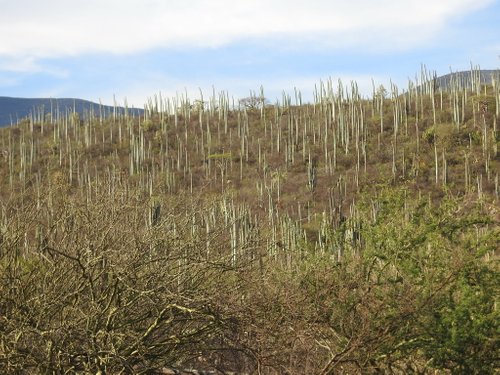
When one visits the deserts of central Mexico there is much to be interested in, but without a doubt, columnar cacti are among the most striking things in these landscapes. Impressive for their size and abundance, these plants can reach an impressive 13 to 17 meters in height and in some places can coexist with up to 1700 individuals per hectare.
Another element that is very impressive about these cacti and that many may not be aware of is their age. These plants are very slow-growing due to the ecosystem in which they live and the difficult environmental conditions to which they have adapted. That makes them need a long time to reach the large sizes they exhibit. Although it is very difficult to assign an exact age to individuals, estimates suggest that the large plants could be between 300 and 500 years old.
To put this in perspective, this means that possibly some of these giants were alive when Hernán Cortés arrived in Mexico. Some of them may have been born during the splendor of Tenochtitlán and have silently witnessed all of Mexico's post-conquest history.
And if that were not impressive enough, their flowers and fruits are also one of the main sources of food for the animals in their ecosystem. This suggests that the disappearance or drastic reduction in number of these plants could mean the "death" of the ecosystem. And another detail, there are several species.
Algunos datos generales Cuando uno visita los desiertos del centro de México hay mucho que interesa, pero sin dudas, los cactus columnares están entre las cosas más llamativas en estos paisajes. Impresionan por su tamaño y por su abundancia, estas plantas pueden alcanzar unos impresionantes 13 a 17 metros de altura y en algunos sitios pueden llegar a coexistir hasta 1700 individuos por hectárea.
Otro elemento que resulta muy impresionante sobre estas cactáceas y que quizás muchos no conozcan es su edad. Estas plantas son de crecimiento muy demorado por el ecosistema en que habitan y las difíciles condiciones ambientales a las que se han adaptado. Eso hace que necesiten mucho tiempo para alcanzar las tallas tan grandes que exhiben. Aunque es muy difícil asignar una edad exacta a los individuos, las estimaciones sugieren que las plantas grandes pudieran rondar una edad entre 300 y 500 años.
Para ponernos un poco en perspectiva, esto significa que posiblemente algunos de estos gigantes estaban vivos cuando Hernán Cortés llegó a tierras mexicanas. Algunos de ellos pueden haber nacido durante el esplendor de Tenochtitlán y han presenciado silenciosamente toda la historia mexicana posterior a la conquista.
Y si esto no fuera lo suficientemente impresionante, sus flores y frutos son además una de las principales fuentes de alimentos para los animales de su ecosistema. Lo que sugiere que la desaparición o drástica reducción en número de estas plantas pudiera significar la “muerte” del ecosistema. Y otro detalle, son varias especies.
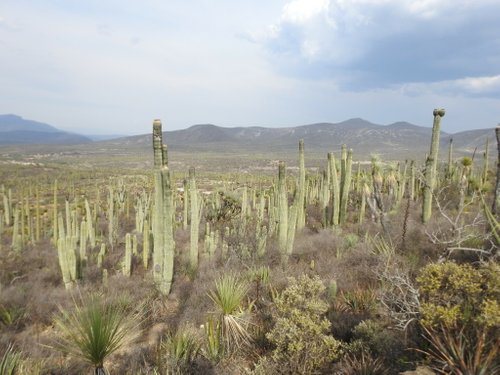
Something I realized is that when you look at a landscape dominated by columnar cacti you tend to think that everything is dominated by a single species. But, although it is true that they are similar and that not all of them can be seen in the same place. It is also true that there are several species coexisting. And although I am not going to refer to all of them, I would like to show you the differences between the four species I have been working with recently.
Algo de lo que me di cuenta es que cuando se mira un paisaje dominado por cactáceas columnares se tiende a pensar que todo está dominado por una sola especie. Pero, aunque es cierto que son semejantes y que no todas se pueden ver en el mismo sitio. También es cierto que hay varias especies coexistiendo. Y aunque no me voy a referir a todas, si me gustaría mostrarles las diferencias entre las cuatro especies con las que estuve trabajando recientemente.
"El Viejito"
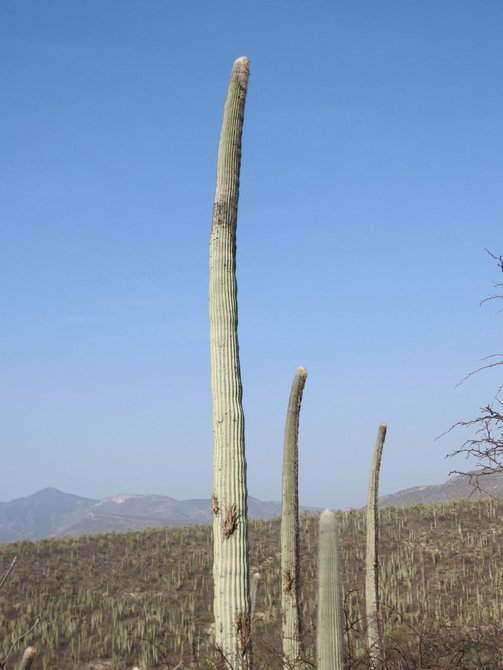
Of the species I am going to talk about today, this is perhaps the easiest to identify. Its scientific name is Cephalocereus coumna-trajani, but the people who live nearby call them "viejitos". And although I am not 100% clear, I think this name has to do with some of the characteristics that allow them to be identified. All individuals of this species curve in a northerly direction as they grow, which gives them the appearance of heavy shoulders like those of an old man.
On the other hand, this species has a pseudocephalium with abundant white wool that also grows on the northern part of the plant and develops along the trunk as the plant grows. This gives it the appearance of a long white beard. Perhaps this could be the origin of the name it receives locally.
The truth is that this pseudocephalium is the reproductive structure where the flowers and fruits originate. Both are surrounded and protected by the wool while they are in formation. Another interesting feature is that the plants of this species do not usually branch, so they grow as a solitary column.
De las especies que voy a habar hoy esta es quizás la más fácil de identificar. Su nombre científico es Cephalocereus coumna-trajani, pero las personas que viven en sus cercanías los llaman “viejitos”. Y aunque no lo tengo 100% claro, creo que este nombre tiene que ver con algunas de las características que permiten identificarlos. Todos los individuos de esta especie se van curvando en dirección norte a media que van creciendo lo que les da la apariencia de hombros cargados como los de un anciano.
Por otro lado, esta especie cuenta un pseudocefalio con abundante lana blanca que crece también en la parte de la planta que se encuentra hacia el norte y que se va desarrollando a lo largo del tronco a medida que a planta crece. Esto le da la apariencia de una barba larga y blanca. Quizás este pudiera ser el origen del nombre que recibe localmente.
Lo cierto es que este pseudocefalio es la estructura reproductiva donde se originan las flores y frutos. Ambos se encuentran rodeados y protegidos por la lana mientras están en formación. Otra característica interesante es que las plantas de esta especie no suelen ramificar, de modo que crecen como una columna solitaria.
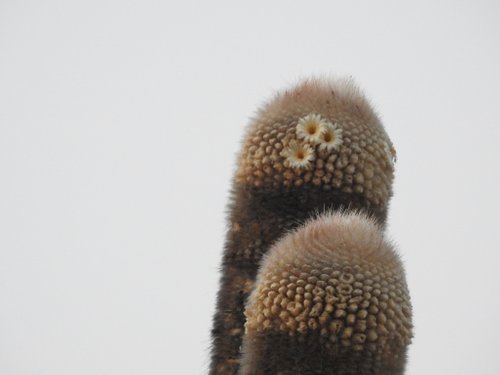
"Tetechas"
This species is usually abundant, its scientific name can be found in encyclopedias as Neobuxbaumia tetetzo or as Cephalocereus tetetzo. It is distinguished because it tends to branch, unlike the old man, it grows erect and does not develop psudocephalium. Its flowers and fruits are borne only at the ends of the branches in a circular arrangement, or resembling a crown. The flowers are usually green and their buds are edible. They are part of several dishes of the local cuisine.
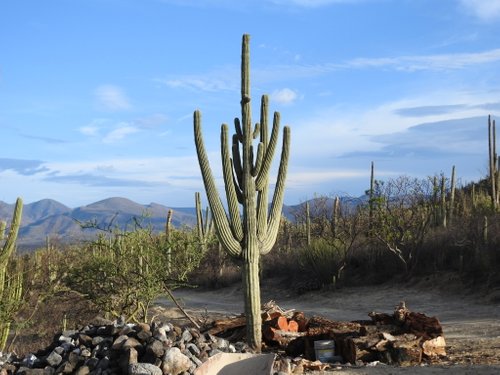
Esta especie suele ser abundante, su nombre científico lo pueden encontrar en las enciclopedias como Neobuxbaumia tetetzo o como Cephalocereus tetetzo. Se distingue porque suele ramificar, a diferencia del viejito, crece erecta y no desarrolla psudocefalio. Sus flores y frutos nacen solamente en los extremos de las ramas en disposición circular, o que asemeja una corona. Las flores suelen ser verdes y sus botones son comestibles. Forman parte de varios platos de la cocina local.
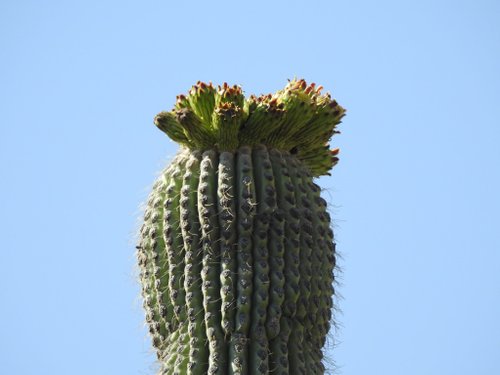
"Falso Tetecho"
This species is similar to the previous one, although much less abundant. Its scientific name is Neobuxbaumia macrocephala or Cephalocereus macrocephalus. Its habit is similar to that of the tetechas and it also commonly branches.
Esta especie es semejante a la anterior, aunque mucho menos abundante. Su nombre científico es Neobuxbaumia macrocephala o Cephalocereus macrocephalus. Tiene un porte semejante al de las tetechas y también ramifica comúnmente.
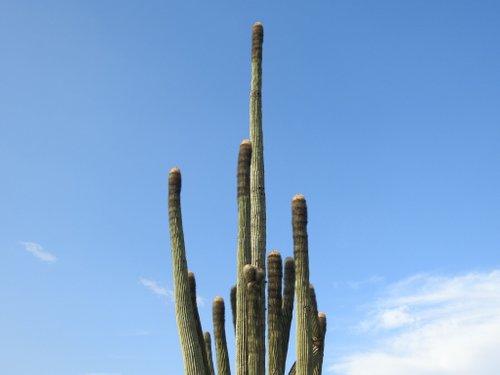
However, it can be easily differentiated because it develops a pseudocephalium at the ends of the branches. Unlike the one found in the old man, this one has much less wool and instead has a large number of long, thin, bristle-like thorns of a reddish color.
These spines turn black as they age. This makes the species reddish towards the ends of the branches and black in between. The flowers also grow only towards the ends of the branches and in the form of a crown. But the number of flowers is usually less than in the tetechas.
Sin embargo, se puede diferenciar fácilmente pues está desarrolla un pseudocefalio en los extremos de las ramas. A diferencia del que encontramos en el viejito este tiene mucha menos lana y en su defecto posee gran cantidad de espinas largas y finas tipo cerdas de color rojizo.
Estas espinas al envejecer se vuelven de color negro. Lo que hace que la especie sea de color rojizo hacia los extremos de las ramas y de color negro en los intermedios de esta. Las flores también crecen solamente hacia los extremos de las ramas y en forma de corona. Pero la cantidad de flores suele ser menor que en las tetechas.

"Tetecho de mezcala"
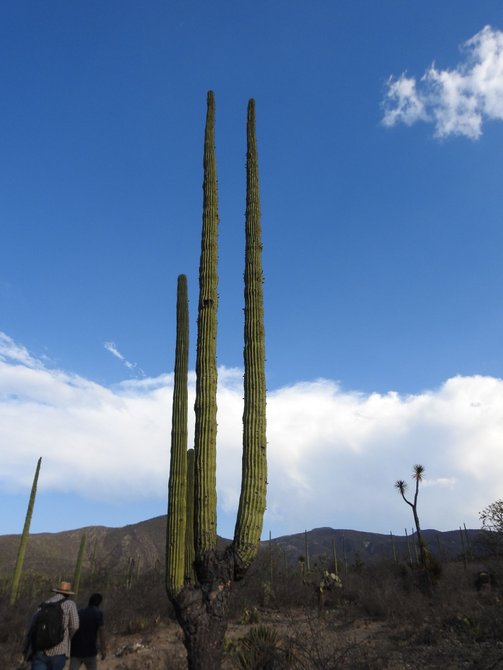
Its scientific name is Neobuxbaumia mezcalaensis or Cephalocereus mezcalaensis. Like the old man this one does not branch unless it receives some type of damage. However, it differs from it in that it does not have pseudocephalium. Another very distinctive feature of this plant is that its flowers are distributed along the entire length of the stem.
Su nombre científico es Neobuxbaumia mezcalaensis o Cephalocereus mezcalaensis. Al igual que el viejito esta no ramifica a menos que reciba algún tipo de daño. Sin embargo, se diferencia de aquel en que no presenta pseudocefalio. Otra característica muy distintiva de esta planta es que sus flores se distribuyen a todo lo largo del tallo.
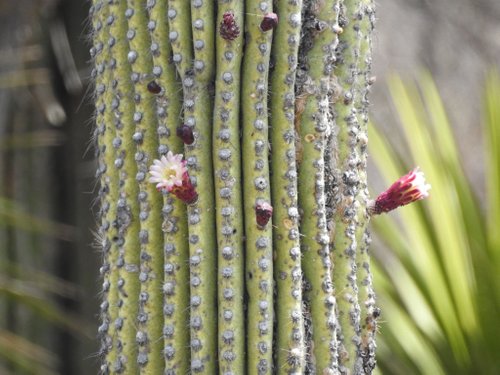
Finally, here is an infographic I made to summarize the information in the post in the hope that it will be easier for you to find the similarities and differences between the different types of Giant Elders. See you soon!
Finalmente, acá les dejo una infografía que hice para resumir la información del post con la esperanza de que les sea más fácil hallar las semejanzas y diferencias entre los diferentes tipos de Ancianos Gigantes. ¡Nos vemos pronto!
This post was translated with help of Deepl
Every images of cactus used in the post were taken from the profile of Ivan Resendiz in Naturalista with verbal authorization from the author.
The pics composition and infographics used where made by the post author in canva.
I also want to give a special thanks to @garorant for the edition work and all the guidance and advice he has helped me with.
La traducción de este post se realizó con ayuda de Deepl
Todas las imagenes de cactus utilizadas fueron tomadas del perfil de Ivan Resendiz in Naturalista with verbal authorization from the author.
La composición de imagenes y la infografía utilizadas fueron realizadas por el autor en canva.
También quiero dar un agradecimiento especial a @garorant por el trabajo de edición y las orientaciones y consejos con los que me ha ayudado.
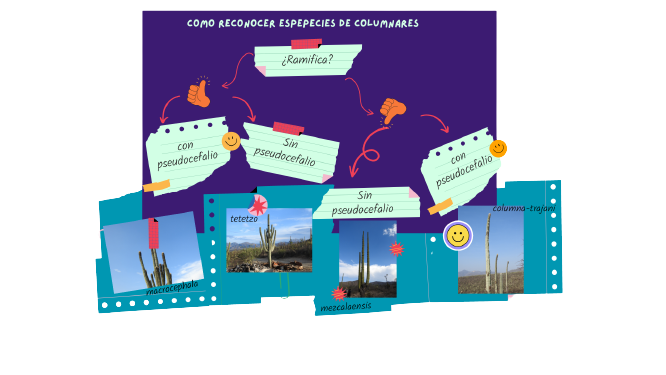
The rewards earned on this comment will go directly to the people( @cpol ) sharing the post on Reddit as long as they are registered with @poshtoken. Sign up at https://hiveposh.com.https://reddit.com/r/cactus/comments/133aehz/are_blogs_about_desert_cacti_allowed_in_this_sub/
Muchas gracias @ceciliajess por tu apoyo!!
A ti por tu excelente post! 🙏❤🥰
Wao! Súper interesante, me encantan los cactus! 🙌❤📸
Gracias por compartir!
Que bien que te gustó! mantente revisando que espero poder publicar algo más sobre cactus o el desierto pronto.
gracias por el voto y el comentario
¡Me encantaron las flores del Tetecho de mezcala. Me gusta lo coloridas que son, y está sumamente interesante e ilustrativa toda esta información sobre los cactus. ¡Sigue publicando más sobre el tema! ¡Saludos! !PIZZA !PGM !CTP
un saludo y gracias por el apoyoGracias @cpol que bueno que también te interesó. Contento de que o disfruten. El Tetecho de Mezcala tambén es mi favorito. Aunque no por el color de sus flores. Espero publicar más sobre esto pronto.
BUY AND STAKE THE PGM TO SEND A LOT OF TOKENS!
The tokens that the command sends are: 0.1 PGM-0.1 LVL-0.1 THGAMING-0.05 DEC-15 SBT-1 STARBITS-[0.00000001 BTC (SWAP.BTC) only if you have 2500 PGM in stake or more ]
5000 PGM IN STAKE = 2x rewards!
Discord
Support the curation account @ pgm-curator with a delegation 10 HP - 50 HP - 100 HP - 500 HP - 1000 HP
Get potential votes from @ pgm-curator by paying in PGM, here is a guide
I'm a bot, if you want a hand ask @ zottone444
$PIZZA slices delivered:
(1/15) @cpol tipped @gornat
Yay! 🤗
Your content has been boosted with Ecency Points
Use Ecency daily to boost your growth on platform!
Support Ecency
Vote for new Proposal
Delegate HP and earn more, by @ceciliajess.
Thanks for your contribution to the STEMsocial community. Feel free to join us on discord to get to know the rest of us!
Please consider delegating to the @stemsocial account (85% of the curation rewards are returned).
You may also include @stemsocial as a beneficiary of the rewards of this post to get a stronger support.
We are sending you HUESO tokens to appreciate your work and the effort you make to share your content with us.
300 y 500 años!!!! me dejas impactada con toda esta información. Me gustan muchísimo los cactus y los coleccionaba hasta que me tuve que mudar. Los regalé a mis amigos como signo de amistad duradera...y creo que no me equivoqué!!!
Gracias @gornat por compartir toda esta información y experiencia formativa en la que estás. Admiro todo lo que haces!! Me encantaría visitar esos desiertos...
Si en efecto @alicia2022 son impresionantes. Lamento que hayas tenido que deshacerte de tu colleción, yo tube que hacer los mismo hace varios años. Gracias a ti por leer y comentar. Lo de visitarlo se puede arreglar. Solo hace fata que te des unas vacaciones por acá.